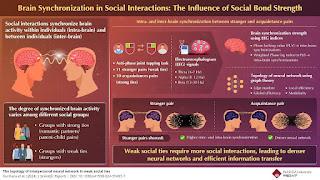Study shows babies learn to imitate others because they themselves are imitated by caregivers
Sep 2023, phys.org
(The whole article is basically a good description of recursion.)
- Social learning avoids laborious trial and error; the wheel does not have to be reinvented each time.
- "Children acquire their ability to imitate because they themselves are imitated by their caregivers"
- Parents respond to the signals given by the child and reflect and amplify them. A mutual imitation of actions and gestures develops.
- "These experiences create connections between what the child feels and does on the one hand and what it sees on the other"
- "Imitation is the start of the cultural process toward becoming human"
- Over the course of generations and millennia, this interplay has led to the cultural evolution of humans"
via Ludwig Maximilian University of Munich: Samuel Essler et al, The cultural basis of cultural evolution: Longitudinal evidence that infant imitation develops by being imitated, Current Biology (2023). DOI: 10.1016/j.cub.2023.08.084.
Image credit: Speaking of memetics, imitation, and learning, the image above is an example of a computer trying to be a human - a graphic designer specifically. We can see how, in very subtle ways, computers can't be people, not just yet: AI Art - Ad Poop - 2024
Social bonding gets people on the same wavelength, neural synchronization study suggests
Mar 2024, phys.org
176 three-person groups of human participants wore caps with fNIRS (functional near-infrared spectroscopy) electrodes while they communicated with strangers in a face-to-face triangle. (But it sounds like they communicated via text message, although they were sitting across from each other.)
This writeup is so concise I have to copy the whole thing:
Each group democratically selected a leader, so each group of three ultimately included one leader and two followers. After strategizing together, groups played two economic games designed to test their willingness to make sacrifices to benefit their group (or harm other groups).Experimenters assigned some triads to go through a bonding session, where they were grouped according to color preferences, given uniforms, and led through an introductory chat session to build familiarity.Bonded groups spoke more freely and bounced between speakers more frequently and rapidly, relative to groups that didn't experience this bonding session. This bonding effect was stronger between leaders and followers than between two followers.Neural activity in two brain regions linked to social interaction, the right dorsolateral prefrontal cortex (rDLPFC) and the right temporoparietal junction (rTPJ), aligned between leaders and followers if they had bonded.The authors state that this neural synchronization suggests that leaders may be anticipating followers' mental states during group decision-making, though they acknowledge that their findings are restricted to East Asian Chinese individuals communicating via text (without non-verbal cues), whose culture emphasizes group cohesion and commitment towards group leaders.
via Beijing Normal University: Ni J, Yang J, Ma Y (2024) Social bonding in groups of humans selectively increases inter-status information exchange and prefrontal neural synchronization. PLoS Biology (2024). DOI: 10.1371/journal.pbio.3002545
 |
| Charting brain synchronization patterns during social interactions - Yuto Kurihara from Waseda University - Apr 2024 |
Charting brain synchronization patterns during social interactions
Apr 2024, phys.org
See the infographic above, really well done.
"Our findings challenge the conventional understanding"Cooperative interactive tasks between individuals with weak social ties result in more synchronized brain activity compared to individuals with strong ties.The participants were given a joint tapping task where they had to tap a mouse button in opposite rhythms. They wore earphones and had to anticipate their partner's movements.Researchers suggest that the lack of familiarity between strangers requires a more involved process for predicting each other's actions or behaviors in a cooperative task. Consequently, this heightened engagement leads to a more efficient transfer of information between closely connected nodes within the neural network.
via Waseda University: Yuto Kurihara et al, The topology of interpersonal neural network in weak social ties, Scientific Reports (2024). DOI: 10.1038/s41598-024-55495-7
Understanding the spread of behavior: How long-tie connections accelerate the speed of social contagion
Apr 2024, phys.org
This is all getting pretty scary; I used to think this was something far off, but it sure seems we have both the knowledge and the means to do these things, and I wonder how it's being done already, and highly doubt it's not being done already. Too irresistible.
Initially, researchers thought highly clustered ties that are close together in networks created the perfect environment for the spread of complex behaviors that require significant social reinforcement. However, long ties, which are created through randomly rewired edges that make them "longer," accelerate the spread of social contagions.
(So this is not about weak vs strong ties, but short vs long.)
Having a small probability of adoption below the contagion threshold is enough to ensure that random rewiring accelerates the spread of these contagions.
"Further work could study such strategies for seeding complex behaviors"
This research suggests those wanting to achieve fast, total spread would benefit from implementing intervention points across network neighborhoods with long-tie connections to other network regions
via University of Pittsburgh Swanson School of Engineering, Sloan School of Management at MIT: Dean Eckles et al, Long ties accelerate noisy threshold-based contagions, Nature Human Behaviour (2024). DOI: 10.1038/s41562-024-01865-0


No comments:
Post a Comment